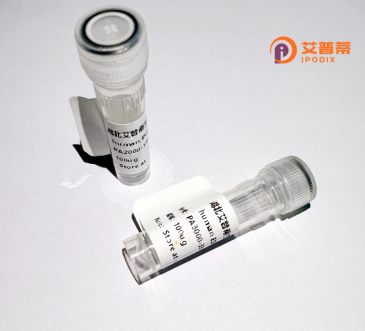
| 纯度 | >90%SDS-PAGE. |
| 种属 | Human |
| 靶点 | SPG11 |
| Uniprot No | Q96JI7 |
| 内毒素 | < 0.01EU/μg |
| 表达宿主 | E.coli |
| 表达区间 | 2095-2387 aa |
| 活性数据 | LVGMKLLDKISSVPHGELSCTTELLILAHHCFTLTCHMEGIIRVLQAAHMLTDNHLAPSEEYGLVVRLLTGIGRYNEMTYIFDLLHKKHYFEVLMRKKLDPSGTLKTALLDYIKRCRPGDSEKHNMIALCFSMCREIGENHEAAARIQLKLIESQPWEDSLKDGHQLKQLLLKALTLMLDAAESYAKDSCVRQAQHCQRLTKLITLQIHFLNTGQNTMLINLGRHKLMDCILALPRFYQASIVAEAYDFVPDWAEILYQQVILKGDFNYLEEFKQQRLLKSSIFEEISKKYKQ |
| 分子量 | 40.7 kDa |
| 蛋白标签 | His tag N-Terminus |
| 缓冲液 | PBS, pH7.4, containing 0.01% SKL, 1mM DTT, 5% Trehalose and Proclin300. |
| 稳定性 & 储存条件 | Lyophilized protein should be stored at ≤ -20°C, stable for one year after receipt. Reconstituted protein solution can be stored at 2-8°C for 2-7 days. Aliquots of reconstituted samples are stable at ≤ -20°C for 3 months. |
| 复溶 | Always centrifuge tubes before opening.Do not mix by vortex or pipetting. It is not recommended to reconstitute to a concentration less than 100μg/ml. Dissolve the lyophilized protein in distilled water. Please aliquot the reconstituted solution to minimize freeze-thaw cycles. |
以下是关于重组人SPG11蛋白的3篇参考文献及其摘要概述:
---
1. **文献名称**:*Loss of spatacsin impairs cholesterol trafficking and calcium homeostasis in human neurons*
**作者**:Boutry, M., et al.
**摘要**:本研究利用CRISPR/Cas9技术构建SPG11基因敲除的人神经元模型,发现SPG11蛋白缺失导致胆固醇运输异常和钙稳态失衡,进而引发轴突退行性变。研究通过重组SPG11蛋白回补实验,部分逆转了表型,证实其在神经元脂代谢中的关键作用。
2. **文献名称**:*SPG11 mutations impair autophagy and DNA damage response in iPSC-derived cortical neurons*
**作者**:Hosseinibarkooie, S., et al.
**摘要**:通过诱导多能干细胞(iPSC)分化的皮层神经元,研究显示SPG11突变导致自噬流阻滞和DNA修复缺陷。重组人SPG11蛋白的过表达恢复了自噬相关蛋白(如LC3-II)的转化效率,并降低了神经元内异常DNA损伤累积。
3. **文献名称**:*Structural insights into the role of SPG11 in the formation of the spatacsin-AP5Z1 complex*
**作者**:Chang, J., et al.
**摘要**:该研究解析了重组人SPG11蛋白与AP5Z1蛋白的复合物晶体结构,揭示了SPG11通过C端结构域介导两者互作。这一结构特征解释了部分临床突变导致复合物不稳定的分子机制,为靶向治疗提供了结构基础。
---
这些研究分别从功能机制、疾病模型和结构生物学角度阐明了SPG11蛋白的生物学意义。如需更多文献,可进一步检索近年关于SPG11蛋白互作组或基因治疗的研究。
The SPG11 protein, encoded by the *SPG11* gene, is primarily associated with autosomal recessive hereditary spastic paraplegia (HSP), a group of neurodegenerative disorders characterized by progressive lower-limb spasticity and weakness. Mutations in *SPG11* are the most common cause of complicated HSP, often presenting with additional neurological features such as cognitive impairment, thin corpus callosum, and peripheral neuropathy. The SPG11 protein, also known as spatacsin, is a large, ubiquitously expressed protein predominantly localized in the cytoplasm, with roles in lysosomal function, autophagy, and intracellular trafficking. Structurally, it contains putative lipid-binding domains at the N-terminus and coiled-coil regions, suggesting involvement in membrane dynamics and protein interactions.
SPG11 interacts with SPG15 (spastizin) to form a complex critical for autophagic lysosome reformation, a process essential for maintaining lysosome homeostasis. Dysfunction of SPG11 disrupts autophagy, leading to abnormal accumulation of autophagic vesicles and impaired neuronal axonal transport. Studies in *SPG11*-deficient models reveal axonal degeneration, synaptic defects, and lysosomal storage abnormalities, highlighting its importance in neuronal survival. Although its precise molecular mechanisms remain under investigation, SPG11 is considered a key player in cellular waste clearance pathways, with implications for understanding neurodegeneration and developing therapies for HSP and related disorders.
×